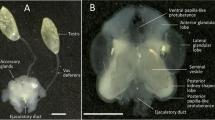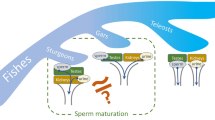Abstract
Nemerteans possess serially arranged gonads that lie between the midgut pouches. In both sexes the gonads are lined with an epithelium. During maturity, they gain contact to the exterior by a ciliated duct, which is generally assumed to be a derivative of the gonad. Gonad lining and sperm ultrastructure are little known in heteronemerteans, a group of nemerteans belonging to the Anopla, one of the two large nemertean subgroups. Reproduction biology in heteronemertean Lineus viridis allows predicting a modified sperm type, so-called introsperm for this taxon. Nothing is known on the fate of the testes at the end of the reproductive period of this perennial species. In order to test the predictions and to broaden the data base, males of L. viridis were collected at different times of the year. Histological and ultrastructural data show that the gonad wall is lined with different aciliated endothelial cells and germ cells, while the gonoduct is formed by densely ciliated cells. The testes are completely filled with sperm cells during maturity; there is no hint at ongoing spermiogenesis at this time. The sperm consists of head, midpiece and tail. Externally, head and midpiece cannot be discriminated. The acrosome is cup-shaped and lies anterior to the nucleus which contains 6–8 lateral ridges. Three long mitochondria mark the midpiece. They line the posterior section of the nucleus and extend up to the level of the ciliary basal structures. The sperm morphology corroborates the predictions derived from the mode of reproduction. At the end of the reproductive period the male gonads change cellular composition, while the gonoduct degenerates. Provided that both sexes show the same growth rate, male offspring acquire sexual maturity earlier than female offspring, since L. viridis males are always smaller than the females. In contrast to the males, females keep their gonads and gonoducts during most time of the year. Since large males were never found within the studied population, these data indicate that L. viridis might be a consecutive hermaphrodite.





Similar content being viewed by others
References
Afzelius BA (1971) The spermatozoon of the nemertine Malacobdella grossa. J submicrosc Cytol 3:181–192
Bartolomaeus T (1984) Zur Fortpflanzungsbiologie von Lineus viridis (Nemertini). Helgoländer Meeresunters 38:185–188
Bartolomaeus T (1985) Ultrastructure and development of the protonephridia of Lineus viridis (Nemertini). Microfauna Marina 2:61–83
Bierne J (1983) Nemertina. In: Adiyodi KG and Adiyodi RG (eds) Reproductive biology of invertebrates, Vol. 1: Oogenesis, oviposition, and oosorption. John Wiley, Chichester, pp 147–167
Franzén Å (1956) On spermiogenesis, morphology of the spermatozoon, and biology of fertilization among invertebrates. Zool Bidr Uppsala 31:355–482
Franzén Å (1983) Nemertina. In: Adiyodi KG and Adiyodi RG (eds) Reproductive biology of invertebrates, Vol. II: Spermatogenesis and sperm function. John Wiley, Chichester, pp 159–170
Friedrich H (1979) Nemertini. In: Seidel F (ed) Morphogenese der Tiere, Vol. 3, D5-1. Gustav Fischer, Jena, pp 1–136
Gibson R (1972) Nemerteans. Hutchinson, London
Gontcharoff M (1951) Biologie de la régénération et de la reproduction chez quelques Lineidae de France. Annals Sci nat Ser 11, (13):149–235
Gontcharoff M (1960) Le développement post-embryonnaire et la croissance chez Lineus ruber et Lineus viridis (Némertes Lineidae). Annals Sci nat Ser 12, (2):225–279
Jespersen Å (1994) Spermiogenesis, sperm structure and fertilization in the palaeonemertean Cephalothrix rufifrons (Nemertini, Anopla). Zoomorphology 114:119–124
Longo F, Clark WH, Hinsch GW (1988) Gamete interactions and sperm incorporation in the nemertean, Cerebratulus lacteus. Zool Sci 5:573–584
Norenburg JL (1985) Structure of the nemertine integument with consideration of its ecological and phylogenetic significance. Am Zool 25:37–51
Oaks J (1978) Ultrastructure of Lineus ruber (Rhyncocoela) epidermis. Tissue Cell 10:227–242
Rouse GW, Jamieson BGM (1987) An ultrastructural study of the spermatozoa of the polychaetes Eurythoe complanata (Amphinomidae), Clymenella sp. and Micromaldane sp. (Maldanidae), with definition of sperm types in relation to reproductive biology. J submicrosc Cytol 19(4):573–584
Stricker SA, Cavey MJ (1986) An ultrastructural study of spermatogenesis and the morphology of the testis in the nemertean worm Tetrastemma phyllospadicola (Nemertea, Hoplonemertea). Can J Zool 64:2187–2202
Stricker SA, Folsom MW (1998) A comparative ultrastructural analysis of spermatogenesis in nemertean worms. Hydrobiologia 365:55–72
Stricker SA, Smythe TL, Miller L, Norenburg JL (2001) Comparative biology of oogenesis in nemertean worms. Acta Zoologica 82(3):213–230
Stricker SA (1985) A new species of Tetrastemma (Nemertea, Monostilifera) from San Juan island, Washington, USA. Can J Zool 63:682–690
Stricker SA (1986) An ultrastructural study of oogenesis, fertilization, and egg laying in a nemertean ectosymbiont of crabs, Carcinonemertes epialti (Nemertea, Hoplonemertea). Can J Zool 64:1256–1269
Stricker SA (1987) Phylum Nemertea In: Kozloff EN (ed) Marine invertebrates of the Pacific northwest. University of Washington Press, Seattle, pp 94–101
Turbeville JM, Ruppert EE (1985) Comparative ultrastructure and the evolution of nemertines. Am Zool 25:53–71
Turbeville JM (1991) Nemertinea. In:. Harrison F W, Bogitsch B.J (eds) Microscopic anatomy of invertebrates, Vol. 3: Platyhelminthes and Nemertinea. Wiley-Liss, New York, pp 285–328
Whitfield PJ (1972) The ultrastructure of the spermatozoon of the hoplonemertine, Emplectonema neesii. Z. Zellforsch.Mikrosk Anat 128:306–316
Acknowledgments
Prof. Dr. R. Dallai (Siena, Italy) gave helpful comments on an earlier version of this manuscript. We are grateful to him as well as to an anonymous referee and Dr. Pat Reynolds (Hamilton, USA) for suggestions to improve the study. Our survey of nemerteans is financially supported by the German Research Foundation (DFG).
Author information
Authors and Affiliations
Corresponding author
Rights and permissions
About this article
Cite this article
von Döhren, J., Bartolomaeus, T. Ultrastructure of sperm and male reproductive system in Lineus viridis (Heteronemertea, Nemertea). Zoomorphology 125, 175–185 (2006). https://doi.org/10.1007/s00435-006-0024-y
Received:
Accepted:
Published:
Issue Date:
DOI: https://doi.org/10.1007/s00435-006-0024-y




